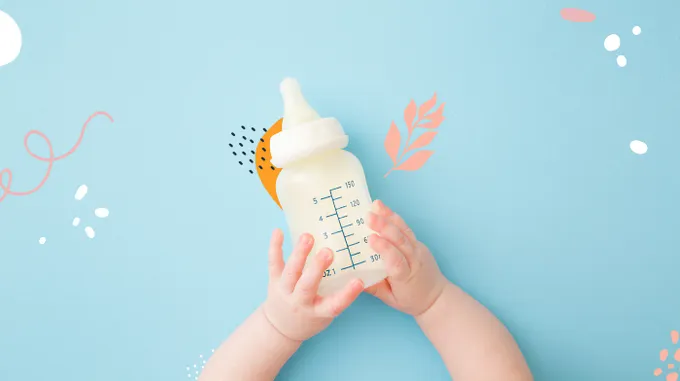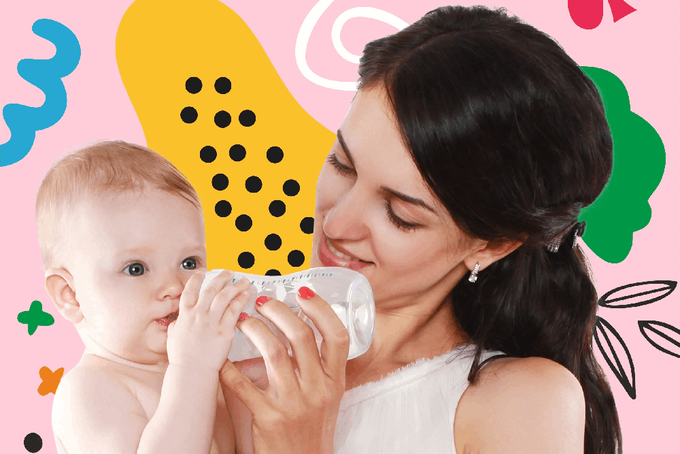Paced Bottle Feeding: What Every Parent Should Know
Learn gentle-paced bottle feeding and empower your baby to control the pace.
Published August 14, 2024

Bottle feeding offers many benefits. It’s convenient and lets other caregivers bond with your baby, whether you’re using breast milk or formula.
But it also raises questions. Maybe you’re worried about nipple confusion if you’re combining breastfeeding and bottle feeding. Or perhaps you’re concerned about gas and reflux, which can make your baby uncomfortable.
Paced bottle feeding might be the answer. This technique mimics breastfeeding and can help with these issues. It’s suitable for all bottle-fed babies, regardless of what they’re drinking or how often they’re fed.
Below, we explain the idea behind paced feeding and how to get started.
» Practice paced bottle feeding with a USDA-certified formula
What is Paced Bottle Feeding?
Paced bottle feeding is all about letting your baby control the process. Instead of rushing through, slow things down to match how breastfeeding works. This can help prevent overfeeding, gas, and nipple confusion.
You're giving your baby a chance to eat at their own pace. It might take longer than a regular bottle feed, but it's worth it for your baby's comfort.
» Learn how to transition from breastmilk to formula
Paced Bottle Feeding Isn't Just for Breastfed Babies
Paced bottle feeding is beneficial for all bottle-fed babies, whether they're exclusively formula-fed or get it as a supplement to breast milk. It respects your baby's natural feeding rhythm and can help prevent overfeeding, gas, and other feeding issues.
Even if you're breastfeeding, including it can be helpful. It can prevent nipple confusion and help your baby learn to pace their feeding, which can benefit them when they're at the breast.
» Read our definitive guide on baby formula ingredients
Benefits of Paced Bottle Feeding
Paced bottle feeding has many advantages for your baby:
- Teaches them to listen to their body. Babies learn to recognize when they're full, preventing overeating.
- Eases tummy troubles. Slower feeding helps prevent gas and discomfort.
- Promotes healthy growth. By avoiding over or underfeeding, your baby grows at a healthy pace.
- Builds a strong bond. Feeding time becomes a special connection between you and your baby.
- Supports healthy mouth development. Paced feeding helps your baby's mouth and jaw grow strong.
- Helps breastfeeding moms. If you're breastfeeding and bottle feeding, paced feeding can prevent nipple confusion.
» Discover things to do when your baby is refusing the bottle
How to do Paced Bottle Feeding
You can start as soon as you introduce a bottle. Here’s how:
- Wash your hands, then sterilize the bottle and nipple.
- Hold your baby upright in your arms. They can be slightly reclined but not flat.
- Gently touch the nipple to your baby's lips to encourage them to open wide.
- Keep the bottle horizontal, like a parallel line. As your baby sucks, tilt it slightly to fill the nipple halfway with milk.
- Let your baby suck and swallow for about 20-30 seconds. Then, lower the bottle to pause the milk flow. Repeat this pattern.
- Watch for signs your baby is full, like pulling away or slowing down.
- Alternate which arm you hold your baby in to mimic breastfeeding.
» Help your toddler make the switch from a bottle to a cup
How To Avoid Overfeeding Your Baby
One of the biggest benefits of paced bottle feeding is preventing your baby from overeating milk or formula.
Don't worry about measuring exactly how much your baby eats. Every baby is different, and there's no set amount they should drink each time.
Most feedings take about 10 to 20 minutes, but this can change. Your baby might eat more or less depending on how long it's been since their last meal or if they're growing quickly. Infants might eat less if they're sleepy, while older babies might get distracted.
Instead of measuring, watch for these signs your baby is hungry:
Signs your baby is hungry:
- Turns head looking for food (rooting)
- Makes sucking noises with their lips
- Seems fussy or restless
- Sucks on their fingers or hands
» Transitioning to a cup? Check out the best toddler sippy cups
Your baby is full if they:
- Open their hands
- Slow down their sucking
- Let go of the bottle
- Turn their head away
- Close their mouth
- Lose interest in eating
- Get sleepy or fall asleep
It's normal for babies to fall asleep while feeding or shortly after. This usually means they're full, even if they haven't finished the bottle. But every infant needs to eat often, so it's okay to wake them up to feed them.
The best way to feed your baby is on demand, which means doing it when they're hungry, not on a strict schedule.
» Read our step-by-step guide on supplementing with formula at night
Choosing the Right Bottle for Paced Feeding
You don't need any special gear to start paced bottle feeding. Any bottle you have can work. But you should consider a few things when choosing a bottle:
- Slow-Flow Nipples: Many experts suggest using nipples labeled "slow-flow" because they help control how quickly your baby gets milk.
- Comfort: Choose a bottle that's easy for you to hold.
- Latch: Your baby needs a good latch, just like breastfeeding. Look for a bottle shape that helps your baby open their mouth. Some babies prefer narrow nipples, while others like wider ones.
Remember:
- If your baby struggles to latch or seems upset while feeding, the milk flow might be too slow.
- If your baby is sputtering or choking, the flow might be too fast.
- You might need to try different bottles to find the best fit for your baby.
If you're unsure about paced feeding or have concerns about your baby's eating habits, talk to a lactation consultant, pediatric dietitian, or your baby's doctor.
» Check out the signs you should switch to a soy-free formula
Nourish Your Baby, Respect Their Cues
Paced bottle feeding is all about listening to your baby. It's a gentle way to feed them that lets them control how much they eat. This helps prevent overfeeding and makes them feel more comfortable.
It takes time to get the hang of it, but the benefits for both you and your baby are huge. Every baby is different, so trust your gut and enjoy this special time together.
To get started, pay close attention to when your baby is hungry and full. Also, choose a bottle and nipple that work for you and your baby. With a bit of practice, you'll be a paced feeding pro.
» Start paced bottle feeding using a Clean Label Project certified formula
FAQs
How to hold a bottle to prevent gas?
Hold the bottle mostly horizontally, with the nipple partially filled, allowing the baby to control the milk flow and reduce air intake.
At what age do you stop paced bottle feeding?
You stop paced bottle feeding when your baby consistently shows signs of fullness and controls their feeding pace, usually around their first birthday.
How do I stop my baby from swallowing air while bottle feeding?
Hold the bottle at a slight angle to keep the nipple filled with milk, preventing air intake. Burp your baby frequently during and after feeding.
Does air in bottle cause colic?
Yes, excess air in a baby's tummy can contribute to colic symptoms. Paced bottle feeding and proper bottle positioning can help reduce air intake.
How do I stop my breastfed baby from guzzling?
Encourage frequent breaks during feeding, allowing the baby to pause and breathe. Consider hand expression to slow milk flow if oversupply is an issue.
Disclaimer: The content and advice provided in this article is for informational purposes only and is not a substitute for medical diagnosis, treatment, or advice for specific medical conditions. Always consult a pediatrician to understand your baby's needs.











